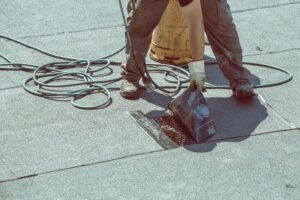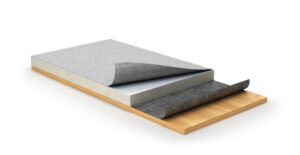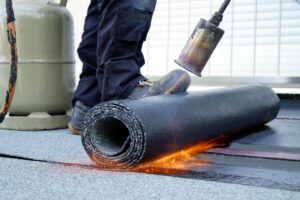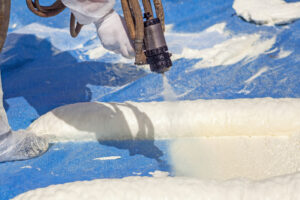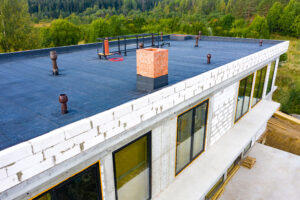While flat roofs are most commonly found over old, western saloons, they also make a wonderful home roof. In fact, homes and residential areas can see many benefits from having flat roofs–especially in arid environments.
Flat roofs do, of course, also have downsides. But every type of roof has its pros and cons, especially depending on the climate and materials used, and the flat roof is no different.
If you’re looking to build a home, buy a home, or replace the roof over your home, use this guide of flat roof types and materials to help direct your decision.
Types of Flat Roofs
There are six main types of flat roofs: EPDM single-layer membrane, built-up, modified bitumen, spray-on, metal, and thermoplastic membrane. Their installation process and their pros and cons are explored below.
EPDM Single-Layer Membrane Roof
The single-layer membrane roof is the newest innovation in flat roofing technology. It is also known as the rubber roof.
As the name suggests, it is made up of one extremely thin layer of synthetic rubber or polymer. The single-layer membrane could be laid down and be fully glued to the deck or held down using river rock ballast.
The single-layer membrane roof is the most popular type of flat roofs.
Benefits
- Longevity – can last between 30-50 years, which beats a lot of higher pitched roofs
- Weight – extremely lightweight and does not need extra reinforcement
- Durability – waterproof, fire resistant, holds up against strong winds, doesn’t scratch easily once installed
- Repairs – doesn’t need to be repaired often–but when it does, homeowners can often do the repairs themselves
- Cost – low material cost, and decreases HVAC costs due to its insulation qualities
- Coverage – full coverage is often offered, making leaks (which are a common concern with flat roofs) extremely rare
Drawbacks
- Installation – while repairs can be a DIY project, the installation must be performed by professionals
- Flexibility – protrusions from the roof need to be properly flashed or leaking will occur
- Fragility – during installation or storms, the roof is very fragile. Some careful maintenance is necessary to keep roof durable and long-lasting
Built-Up Roof
The oldest of the three types, built-up roofing has been around for over a century. It has had the solution to the low pitches of flat roofs long before nearly any other type of roofing material.
Built-up roofs are made of several layers of roofing felt that has been mixed with asphalt and bitumen. Hot tar is then used to meld layers together to create one, cohesive membrane.
This is repeated for a few tiers, and then a layer of fine granules is placed on top to protect the roof from weather.
Benefits
- Longevity – can last between 10 to 15 years
- Durability – resists power of UV rays, wind, and water
- Repairs – layers peel away easily for repairs
- Variety – many types of material possible
- Maintenance – very little required
Drawbacks
- Installation – hefty, time-consuming installation. Installation can also create dangerous fumes–wear a mask!
- Cost – with labor, materials, and potential danger to workers, the cost can be quite steep
- Weight – incredibly heavy; may need extra support just to hold it
- Fragility – in extremely windy or rainy conditions, significant damage can be done to the roof
- Repairs – should a leak occur, it may be extremely hard to find the origin
Modified Bitumen Roof
Developed in the 20th century, modified bitumen roofing came about as a replacement to built-up roofing methods.
Modified bitumen is installed in multiple layers, similar to the built-up roof. However, each layer is torched to the surface in order to create the desired cohesion.
While there are now a few ways to install modified bitumen roofs without the use of torching, these methods do require quite a bit of tar and are still quite labor intensive.
Benefits
- Longevity – expected to last between 10-15 years
- Appearance – has the look of asphalt shingling. Also, since it is rolled and torched, it appears to be seamless
- Durability – weather resistant, including thermal resistance to cold temperatures
- Cost – often is the lowest-priced flat roofing option
- Environmentally-Friendly – recyclable!
Drawbacks
- Installation – using an open flame to seal the roof makes the installation process tricky. The modified bitumen roof is definitely not a DIY project.
Spray-On Roof
A spray-on roof is not as sketchy as it may sound.
More accurately known as a spray polyurethane foam roof, spray-on roofs start with a layer of polyurethane foam that is rather dense in order to help create the durability necessary for a roof. A waterproofing top coat is then placed on top.
Benefits
- Longevity – potential to last 40 years
- Appearance – seamless appearance due to the nature of the installation process
- Durability – waterproof and weather resistant overall
- Flexibility – can cover even the most unique shapes and protrusions of roof as it is installed using a wand or hose. Also, can be applied over existing roof
Drawbacks
- Cost – has one of the highest costs of flat roofs
- Installation – complex installation, possibility for hazardous fumes, and if not installed correctly, the whole system could fail
Thermoplastic Membrane Roof (PVC or TPO)
Thermoplastic membrane roofs are very similar to the single-layer and are sometimes even put into the same category.
Like the singly-layer membrane, thermoplastic membrane roofs are also comprised of a single layer of material. While they can be adhered like the EPDM roofs, they can also be bolted and screwed in instead of weighed down with river rocks.
Since it is more of a plastic than a rubber, these roofs are much more durable.
Benefits
- Longevity – PVC have lifetime warranties. Others can last anywhere between 30 to 50 years
- Weight – needs no extra support
- Durability – extremely durable. TPO is also energy efficient, keeping UV rays away and the home properly insulated
- Cost – TPO comes at a far lower cost than PVC
Drawbacks
- Installation – professional expertise with experience in this particular type of roofing required or the roof may be prone to leaks
- Cost – PVC has one of the highest installation and material costs
Metal Roof
Using metal for a flat roof is extremely common, especially in residential areas. They can last 35 years under the right conditions.
Metal flat roofs are usually made from aluminium. Often one sheet is designed to cover the whole roof, but strips can also be attached to the roofing deck to fit around protrusions.
Benefits
- Longevity – with the proper maintenance and in aluminum, 50+ years is not unusual
- Durability – resistant against wind, fire, and water
- Flexibility – can be cut to fit strange roof shapes and mold around protrusions around roof
- Weight – lightweight
- Cost – relatively inexpensive
Drawbacks
- Replacement – the whole roof often has to be torn out in order to replace the old metal roofing
- Maintenance – longevity could be greatly reduced if rust begins to eat away at the roofing material
Conclusion
No matter what type of flat roof you choose to install, know that it has great potential. In fact, it’s often just the beginning of a whole new world–especially with options like green roofs available.
References
https://www.thespruce.com/pros-and-cons-flat-roofing-systems-1824698
https://www.thespruce.com/types-of-flat-roof-material-options-1824707
https://www.roofingcalc.com/flat-roof-materials/#modified%20bitumen
https://modernize.com/home-ideas/30547/best-options-for-replacing-a-flat-roof
https://www.roofcalc.org/70-flat-roof-facts/
http://www.exteriorproinc.com/blog/bid/341594/Most-Common-Types-of-Flat-Roofing-in-Indiana
https://www.angieslist.com/articles/flat-roof-better-sloped-roof.htm
